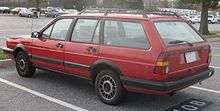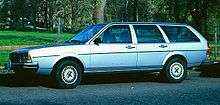Volkswagen Passat (B2)
| Volkswagen Passat (B2) | |
|---|---|
 | |
| Overview | |
| Also called |
Volkswagen Corsar Volkswagen Carat |
| Production | 1981–1988 |
| Assembly |
Emden, Germany Barcelona Zona Franca, Spain São Bernardo do Campo, Brazil Puebla, Puebla, Mexico Shanghai, China Zama, Japan Uitenhage, South Africa |
| Body and chassis | |
| Class | Mid-size car / Large family car (D) |
| Body style |
2-door saloon/sedan (Latin America) 3-door hatchback 4-door saloon/sedan (Santana) 5-door hatchback 5-door estate/wagon |
| Layout |
Front engine, front-wheel drive or four-wheel drive |
| Platform | Volkswagen Group B2 |
| Related |
Audi 80 (B2) Ford Versailles Ford Royale Volkswagen Quantum Volkswagen Santana |
| Powertrain | |
| Engine |
|
| Transmission |
3-speed automatic, 4-speed manual, 5-speed manual |
| Dimensions | |
| Wheelbase | 2,550 mm (100.4 in)[2] |
| Length |
3/5d: 4,435 mm (174.6 in)[2] Variant: 4,540 mm (178.7 in)[2] Santana: 4,545 mm (178.9 in)[2] 179.5 in (4,559 mm) (GL) 180.7 in (4,590 mm) (GL Syncro) |
| Width |
1,685 mm (66.3 in)[2] Santana: 1,695 mm (66.7 in)[2] 67.2 in (1,707 mm) (GL) 66.7 in (1,694 mm) (GL Syncro) facelifted Santana: 1,710 mm (67.3 in) |
| Height |
1,385 mm (54.5 in)[2] Santana: 1,400 mm (55.1 in)[2] 54.8 in (1,392 mm) (GL) 58 in (1,473 mm) (GL Syncro) facelifted Santana: 1,427 mm (56.2 in) |
| Chronology | |
| Predecessor | Volkswagen Passat (B1) |
| Successor | Volkswagen Passat (B3) |
The Volkswagen Passat (B2) is an automobile which was produced by German manufacturer Volkswagen from 1981 to 1988. It was the second generation of the Volkswagen Passat. The platform was slightly longer than the preceding Passat (B1) and the car's updated styling was instantly recognisable as a Passat, with the most obvious difference being the rectangular headlights. As with the previous generation, it was based on the platform of the Audi 80; the corresponding B2 version of which had been already launched in 1978. Unlike the previous B1 80/Passat, there were much more pronounced styling differences between the two cars, as well as the Passat having a completely different dashboard and interior compared to its Audi 80 sister. In most markets, the equipment levels were renamed from L/LS/GLS to CL/GL/CD.
In addition to the Passat hatchbacks and Variants (estate/wagon), there was also a conventional three-box saloon, which until the 1985 facelift was sold as the Volkswagen Santana in Europe. In North America, the Passat/Santana was sold as the Volkswagen Quantum, available in three-door hatchback, four-door sedan, and a wagon model, but the five-door hatchback was never sold there and the three-door hatchback was dropped after less than two years. The four-wheel drive Syncro version was introduced in October 1984, initially only with the more powerful two-litre five-cylinder engine.

The Santana was also produced in China, Brazil, Mexico (as the Corsar, from 1984 and 1988) and Argentina (as the Carat between 1987 and 1991). In Brazil, the Santana station wagon was sold as the Quantum. The Passat saloon and estate were produced in South Africa for their local market until 1987. As of 2010 the B2 Santana is still in production in China.

Like the previous generation, the B2 Passat was mainly sold with four-cylinder petrol and diesel engines. Unlike its predecessor, however, top-of the line versions received five-cylinder Audi or VW engines of 1.9–2.2 litres.[1][3] In addition to four- and five-speed manuals and three-speed automatic gearboxes, the Passat/Santana was also available with the VW concern's interesting 4+E transmission. This, also called the "Formel E" had a particularly high top gear, which combined with a freewheeling mechanism to provide better gas mileage. An automatic stop/start was also available in some markets.
The four-wheel drive system used in the Passat Variant Syncro shared the mechanics of the Audi 80 quattro rather than the Volkswagen Golf Syncro. When first shown, at the 1983 Frankfurt Motor Show, the car was meant to be called the "Passat Tetra".[4] The Syncro's bottomplate was almost entirely different, requiring a transmission tunnel, a relocated gas tank, and no spare tire well (to make room for the complex rear axle assembly). Unlike the related Audi 80 quattro which used a reversed front wheel setup, the rear-axle was an adapted Volkswagen Transporter unit so as to retain a flat loading floor. Only the more popular estate was deemed worthy of reengineering, so as to not offer direct competition with the sedan-only Audi 80 quattro.[4] Syncro was also available in the North American market, only with the five-cylinder engine.
1985 Facelift

In 1985 the range received a slight facelift, consisting of new, larger bumpers, interior retouches, a new front grille and new taillights on the hatchback versions. The three-door hatchback was discontinued while the Santana nameplate was dropped in Europe. The saloon's front end was now the same as the hatchback and estate. The North American version, still known as the Quantum, gained European-style composite headlamps.
On March 31, 1988 production ended (although Syncro models continued in production until June) with 3,345,248 built in Germany. World production totals amount to at least 4.5 million units.
References
- 1 2 3 James M. Flammang (1994). Standard Catalog of Imported Cars, 1946-1990. Iola, WI: Krause Publications, Inc. pp. 639–642. ISBN 0-87341-158-7.
- 1 2 3 4 5 6 7 8 Auto Katalog 1983. Stuttgart: Vereinigte Motor-Verlage GmbH & Co. KG. 1982. pp. 206–207.
- ↑ World Cars 1982. Pelham, NY: The Automobile Club of Italy/Herald Books. 1982. pp. 135–137. ISBN 0-910714-14-2.
- 1 2 Verhelle, Tony (1983-10-13). "Frankfurt: vervolg en slot" [Frankfurt continued]. De AutoGids (in Flemish). Brussels, Belgium: Uitgeverij Auto-Magazine. 5 (106): 36–37.
| « previous — Volkswagen Passenger Cars, a marque of the Volkswagen Group, car timeline, European market, 1980s–present | |||||||||||||||||||||||||||||||||||||
|---|---|---|---|---|---|---|---|---|---|---|---|---|---|---|---|---|---|---|---|---|---|---|---|---|---|---|---|---|---|---|---|---|---|---|---|---|---|
| Type | 1980s | 1990s | 2000s | 2010s | |||||||||||||||||||||||||||||||||
| 0 | 1 | 2 | 3 | 4 | 5 | 6 | 7 | 8 | 9 | 0 | 1 | 2 | 3 | 4 | 5 | 6 | 7 | 8 | 9 | 0 | 1 | 2 | 3 | 4 | 5 | 6 | 7 | 8 | 9 | 0 | 1 | 2 | 3 | 4 | 5 | 6 | |
| Economy car | Beetle | ||||||||||||||||||||||||||||||||||||
| City car | Lupo | Fox | up! | ||||||||||||||||||||||||||||||||||
| Supermini | Polo / Derby I | Polo / Derby II | Polo III | Polo IV | Polo V | ||||||||||||||||||||||||||||||||
| Small family car | Golf I | Golf II | Golf III | Golf IV | Golf V | Golf VI | Golf VII | ||||||||||||||||||||||||||||||
| Jetta I | Jetta II | Vento | Bora | Jetta V | Jetta VI | ||||||||||||||||||||||||||||||||
| New Beetle | Beetle | ||||||||||||||||||||||||||||||||||||
| Large family car | Passat I | Passat II / Santana | Passat III | Passat IV | Passat V | Passat VI | Passat VII | Passat VIII | |||||||||||||||||||||||||||||
| Passat CC | CC | ||||||||||||||||||||||||||||||||||||
| Luxury car | Phaeton | ||||||||||||||||||||||||||||||||||||
| Coupé | Scirocco I | Scirocco II | Scirocco III | ||||||||||||||||||||||||||||||||||
| Corrado | |||||||||||||||||||||||||||||||||||||
| Convertible | Golf I Cabriolet | Golf III Cabriolet | Golf VI Cabriolet | ||||||||||||||||||||||||||||||||||
| New Beetle Cabriolet | Beetle Cabriolet | ||||||||||||||||||||||||||||||||||||
| Eos | |||||||||||||||||||||||||||||||||||||
| Compact MPV | Golf Plus | Golf Sportsvan | |||||||||||||||||||||||||||||||||||
| Touran I | Touran II | ||||||||||||||||||||||||||||||||||||
| Large MPV | Sharan I | Sharan II | |||||||||||||||||||||||||||||||||||
| SUV | Tiguan I | Tiguan II | |||||||||||||||||||||||||||||||||||
| Touareg I | Touareg II | ||||||||||||||||||||||||||||||||||||
| |||||||||||||||||||||||||||||||||||||
| « previous — Volkswagen Passenger Cars, a marque of the Volkswagen Group, car timeline, United States/Canada market, 1980–present | ||||||||||||||||||||||||||||||||||||||
|---|---|---|---|---|---|---|---|---|---|---|---|---|---|---|---|---|---|---|---|---|---|---|---|---|---|---|---|---|---|---|---|---|---|---|---|---|---|---|
| Type | 1980s | 1990s | 2000s | 2010s | ||||||||||||||||||||||||||||||||||
| 0 | 1 | 2 | 3 | 4 | 5 | 6 | 7 | 8 | 9 | 0 | 1 | 2 | 3 | 4 | 5 | 6 | 7 | 8 | 9 | 0 | 1 | 2 | 3 | 4 | 5 | 6 | 7 | 8 | 9 | 0 | 1 | 2 | 3 | 4 | 5 | 6 | 7 | |
| Subcompact | Fox | |||||||||||||||||||||||||||||||||||||
| Compact | Rabbit I | Golf II | Golf III | Golf IV | Rabbit V | Golf VI | Golf VII | |||||||||||||||||||||||||||||||
| Jetta I | Jetta II | Jetta III | Jetta IV | Jetta V | Jetta VI | |||||||||||||||||||||||||||||||||
| Dasher | New Beetle | Beetle | ||||||||||||||||||||||||||||||||||||
| Mid-size | Quantum | Passat III | Passat IV | Passat V | Passat VI | Passat VII | ||||||||||||||||||||||||||||||||
| Full-size | Phaeton | |||||||||||||||||||||||||||||||||||||
| Coupé | Scirocco I | Scirocco II | Corrado | CC | ||||||||||||||||||||||||||||||||||
| Convertible | Rabbit Convertible | Cabriolet | Cabrio | Eos | ||||||||||||||||||||||||||||||||||
| New Beetle Convertible | Beetle | |||||||||||||||||||||||||||||||||||||
| Van | Vanagon | Eurovan | Routan | |||||||||||||||||||||||||||||||||||
| Pickup | Rabbit Pickup | |||||||||||||||||||||||||||||||||||||
| Crossover | Tiguan | |||||||||||||||||||||||||||||||||||||
| Mid-size SUV | Touareg | Touareg II | ||||||||||||||||||||||||||||||||||||
| ||||||||||||||||||||||||||||||||||||||